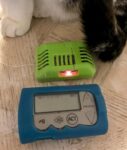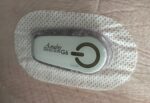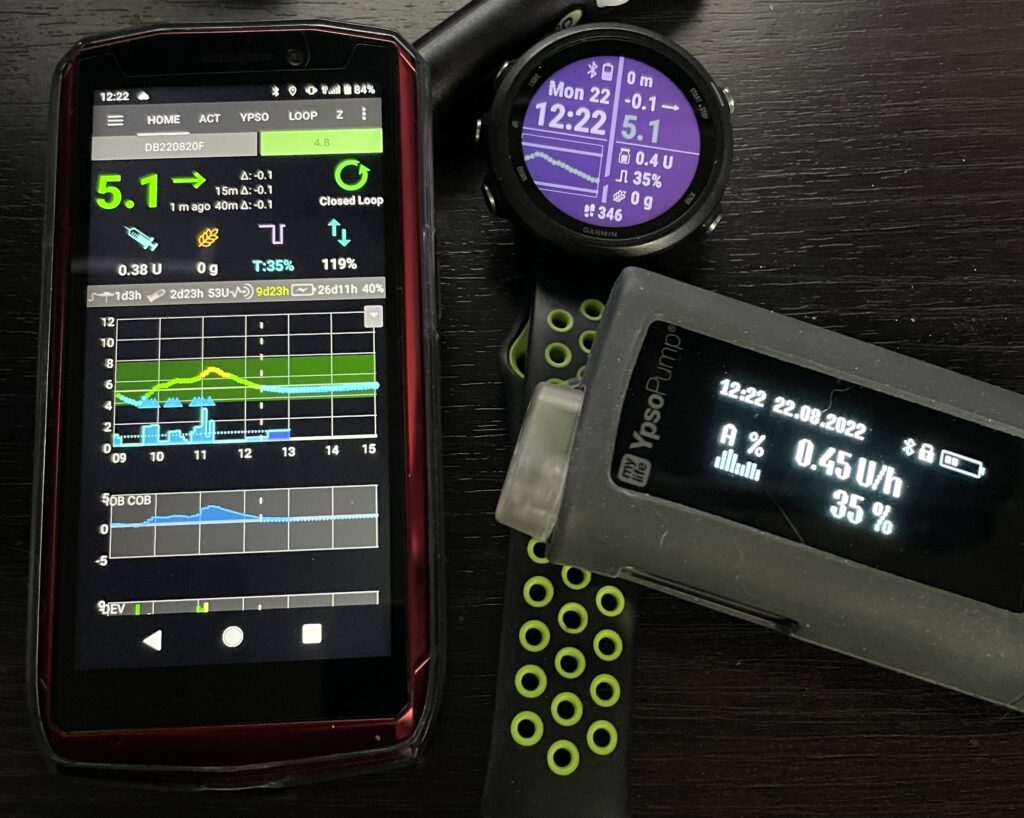What’s a quinquennial? A 5-year anniversary. Yes, it was a whole 5 years ago I finally set up my “DIY” closed-loop.
I’m obviously still using it, although there’ve been lots of changes along the way. Both in terms of improvements in clinical results and in terms of quality of life.
What’s changed in the technology?
 I started out with OpenAPS, running on a pocket “Edison” Linux computer and driving a Medtronic Paradigm 522 insulin pump. My CGM was using Libre1 sensors, managed by an Android phone (connected to the Edison via Bluetooth).
I started out with OpenAPS, running on a pocket “Edison” Linux computer and driving a Medtronic Paradigm 522 insulin pump. My CGM was using Libre1 sensors, managed by an Android phone (connected to the Edison via Bluetooth).
 Along the way the CGMs I’ve used have included Libre1 and Libre2, Dexcom G5 and G6, and even PocTech and Medtronic systems! G6 is my current stable base.
Along the way the CGMs I’ve used have included Libre1 and Libre2, Dexcom G5 and G6, and even PocTech and Medtronic systems! G6 is my current stable base.

I’ve used quite a few pumps, but today I mostly use YpsoPump and Omnipod DASH pumps. These are small and compact devices. I’ve been very lucky to work with the OPN clinical-trial versions of the YpsoPump.
My current hardware
The device that controls it all has shrunk too.

Today the controller I’m using is a Cubot Pocket phone. An Android 11 device with a 4″ screen, enough battery to last almost 2 days between charges, and excellent Bluetooth connectivity. It’s a shame it’s not rugged/waterproof too (although if I’m heading off for watersports I can switch to other devices which are). It’s linked to my Garmin Forerunner watch, which I find a useful tool in managing my exercise.
The software I’m usually running is very similar to AndroidAPS. It’s something we’ve instrumented with extra controls for use in clinical trials, but pretty much everything I’m using exists in AndroidAPS. In fact the underlying algorithm is the same as OpenAPS.
Why use opensource AID systems?
When I started out there were no commercial AID choices. Today in Australia we have Tandem’s Control-IQ, Medtronic’s 2nd-generation 780G, and Ypsomed’s CamAPS is being introduced. So I’ve occasionally been asked:
“With commercial systems available, why would anyone use ‘DIY’ systems?”
The answers will of course vary for each of us, but several responses immediately spring to my mind:
- The commercial systems will help lots of people: on the whole they achieve better clinical results than most of us manage without the automation!
- But they’re not as flexible.
They’re not (in my experience) as capable. There’s a difference between “better than without” and “non-diabetic” levels. - They often involve a lot of management and hand-holding to keep running. The phrase “quality of life” is relevant.
This is a relative thing: see below for my experience. - And they’re always playing catch-up.
I’ve not yet seen a commercial system “leapfrog” the abilities of the opensource systems. The closest to that might be the Omnipod5 system in the US, where the loop is integrated into each insulin pod so no extra device is needed. But that’s only part of the feature set to consider.
In short the commercial systems may be improving, but so are the opensource systems!
The “diabetic life” after 5 years of looping
Indeed, after almost 40 years of living with T1D.
No commercial system claims to support the functionality I’ve had with my own loop for several years now:
- Just to put the following things in context, I definitely have T1D: without insulin I would soon die.
- I don’t give myself insulin for food. I don’t even count carbs.
- I still tell the system when I’m going to be exercising, but otherwise it runs everything in the background.
- I can change between CGMs and pumps as suits me. I’m not locked into a single choice.
- I can integrate my setup with lots of associated technology. The Garmin ecosystem is just one example.
I just glance at my watch every now and then to see how it’s going, and get back on with living life. Occasionally I adjust settings when I notice patterns changing, and I do replace CGM sensors and pump reservoirs/infusion sets when needed. But diabetes does not feel like a day-to-day burden.
And yet my clinical results are not terrible either.
My time-below-3.9 (70 mg/dL) currently hovers around 2%.
My time-in-range for 3.9-7.8 (70-140) hovers around 87%.
My TIR for 3.9-10 (70-180) hovers around 96%.
My HbA1c generally hovers between 5.1-5.5% (32-37 mmol/mol).
I know I could get even “better” results if I put in more work day-to-day, but for now I’m more than happy with this compromise.
Some users of opensource AID systems (e.g. Loop on iPhones) say to me that they’re not interested in the commercial systems because with those they can’t bolus from their watch. In response I think “You have to bolus???”. I can with the system I use, but I don’t have to.
Everyone’s expectations are based on their experiences.
Now what?
I can’t see the opensource systems going away any time soon, and I can only try to imagine what features we’ll have access to in another 5 years!

Tremendous achievement. Would you call entering exercise some degree short of a full closed loop, or is the distinction somewhat academic? Reading your blog and sharing your insight and experimentation is always a treat. I’ve learned a tremendous amount from you. You’ve inspired my approach to management. Thank you.
I think it’s as-close-to-closed as we can get for now. With the long tails of subcutaneous insulin delivery, there’s no obvious alternative to warning the system about exercise beforehand.
Thanks for the kudos Jon!
Hi David,
Congratulations on the five year anniversary.
Its not only yourself who has benefitted from your achievement, many others you have inspired have also benefitted greatly. Something you should be very proud of.
As I silent follower (and frequent copier) of the hardware you use I’m interested to find out why you changed from the Cubot kingkong mini to Cubot pocket. is it just natural phone progression to a newer model or did you have problems with kingkong mini.
I recently had to revert back to an old Samsung because I could not get my Kingkong set up properly (not sure if it was new APS update or change to G6, which both near to each other)
Interested in your insight (if its a simple answer)
congratulations again David.
The transition from the KingKong Mini 2 to the Pocket gave a few updates:
I was hoping the NFC would let it interact with Libre sensors, but apparently (like the Unihertz phones) the chipset doesn’t implement the required NFC sub-standards for that.
Currently my KKM2 is my backup device. I’m all about having disaster-recovery backups, and it helps when they’re not super-expensive.
Hi David, congrats on the 5 year anniversary. I very much appreciate all your great work in this area. Non commercial closed loop has transformed quality of life for our whole family since our ten year old son moved to this system. We are very grateful for the pooled wisdom of everyone advancing diabetes management systems. I have loved to see you presenting non commercial looping in the diabetes conferences and forums as a valid alternative. As an aside, in the tertiary hospital where I work, the ‘grand rounds’ (multi specialty meeting of medical doctors) meeting last week was entirely on non commercial closed looping. It generated loads of discussion and interest. As an audience member, I was so pleased to see education re non commercial closed looping spreading throughout the medical community in this way. Thanks for all your looping work!
Congratulations, David!
It’s difficult to appreciate how my life has changed since mid-June this year, when I was waiting to receive a trial box of Dexcom G6 sensors and transmitter in preparation for the NDSS subsidy for CGMS to be introduced. I had used MEdtronic’s Enlite, Guardian and Guardian 3 CGM systems oover the past few years but found them to be unsatisfactory, to say the least, and I would only use them for short bursts when I managed to pick up some about-to-expre or just-expired sensors from someone overseas. I assumed that I would finally, after 20 years, part ways with Medtronic and move to a t-slim when the warranty ran out on my 670G next May so I was digging around on the internet to get a better understanding for people’s experiences with the t-slim and, especially, the G6 and I came across your blog. That was a life changing moment!
Somehow, I had never heard about DIY looping before (as a PWD of 30-odd years who has an interest in tech and gadgets, how did that happen?) but reading about your anniversary of bo-bolus looping was an epiphany. Comparing Medtronic’s 670G Auto-mode, which was a worse experience than manual mode to a DIY system that almost eliminated the worst aspect of diabetes (no, not needles or finger-pricks, as the public at large and most of the non-diabetics developing treatment systems for us like to think – and tell us): the constant worry, stress, calculation and general mental burden, was unimaginable.
I had one of my old 722s still in working order so I soon placed an order for an Orangelink and started to read up on AndroidAPS (as an Android devotee, it made the most sense plus it seemed to be working well for you). I completed my first AAPS build and started on Objective 1 just before the end of June and I completed Objective 10 yesterday. I’ve just gone 3 days, during which I ate paella, ramen noodles and lasagne (a bit more carb-intensive than my usual diet, which still includes a fair number of carbs), without bolusing or announcing carbs while maintaining a TIR (3.9 – 10) over 90%. There’s still lots of room for learning and fine-tuning to bump that number up a bit more but it’s still chalk and cheese compared to my (likely) control beforehand and the weight that has been lifted from my mind is greater than anything that therapy or anti-depressants has ever been able to acheive.
So, congratulations again, and thank you so much for providing the inspiration for another Aussie to finally take charge of his diabetes – and I know that I am not alone (Aussies and non-Aussies alike) in being able to thank you for that. You deserve a knighthood – or an AO, no, make that an AC!
Very inspiring! I am aiming to do the same as you but see two main road blocks to personally achieving a closed-loop.
1. For higher glycemic foods such as oatmeal and pasta, my blood sugar inevitably runs high ( > 10 mmol/l) after eating even if I bolus all needed insulin to cover the carbs concurrently with the meal. I use am using Fiasp insulin. How do you sustain such a high TIR % with the closed loop?
2. When I do intense exercise, I often need to do more than simply suspending basal delivery during the exercise to prevent hypoglycemia. If I have any appreciate IOB and my current glucose levels are in a normal range, I must consume some amount of carbs to prevent lows during exercise. Do you experience this as well?
Thanks so much for what you do.
Rob
1. The loop is able to essentially “micro-dose” on every CGM update, and it will generally start doing that before the stage that I would decide to do a larger correction bolus if I was running everything manually. Of course it’s doing lots of clever maths to try to avoid over-dosing, but those repeated micro-corrections are fairly important.
Occasionally I do go over 10 mmol/L, but when it does I generally have faith that the system has already been dosing for that, and experience says it will come down by itself before long.
2. Aerobic exercise can cause the muscles to “suck up” any available insulin and induce hypoglycaemia. The insulin hangs around for some time: I generally set a high “temp target” at least an hour beforehand so the system starts letting me ride a little high (which it does by reducing IOB). This includes getting rid of a lot of the “basal IOB”: not just your last bolus.
Sometimes I do need to eat snacks as well though.
AndroidAPS doesn’t has YpsoPump support still. How’d you managed to use it? Some kind of closed-source driver?
I’m not actually using “AndroidAPS”, I’m using a research version, and I’m also using a version of the YpsoPump which is not the publicly-available version. We got special ones for use in several clinical trials and I wrote the driver for them. Once we get it working with the public version of the pump (an ongoing effort) the driver will become available to AndroidAPS and I think there’ll be a lot of celebration. There are “a few moving pieces” to that puzzle.
Hi David,
I was wondering max minutes of basal to limit SMB w/ and w/out an UAM setting you were using, 120 minutes? Also, have you experimented with AutoISF to extend the max SMB/UAM basal range?
Finally, have you learned about any new insulins that are in development that will be faster acting than Lyumjev?
Thank you,
Rob
I’m currently using 120/90 for max-basal-minutes (90 for UAM).
No I’m not across any insulins faster than Lyumjev yet. I wouldn’t be surprised if we’re reaching a plateau of what can be achieved with subcutaneous insulin delivery.